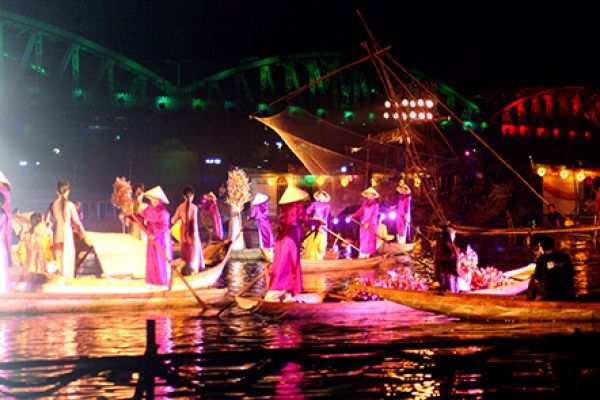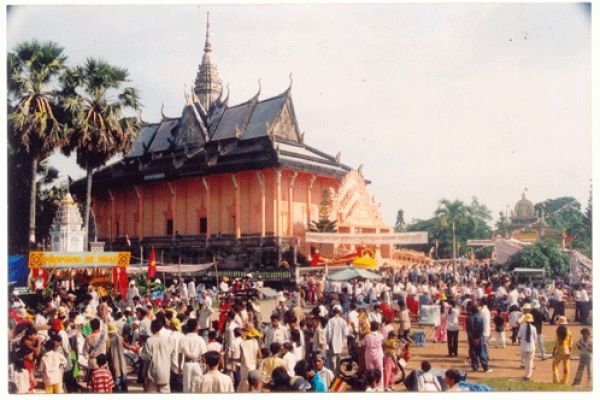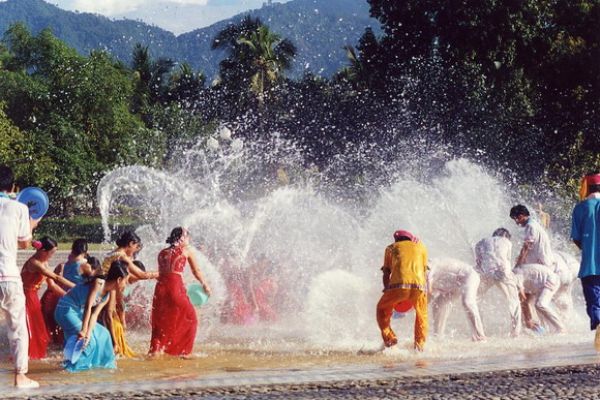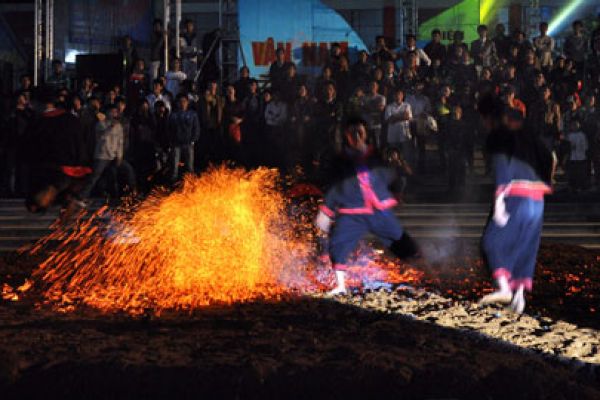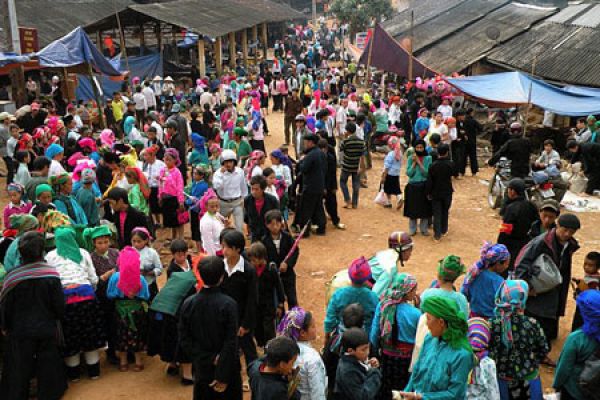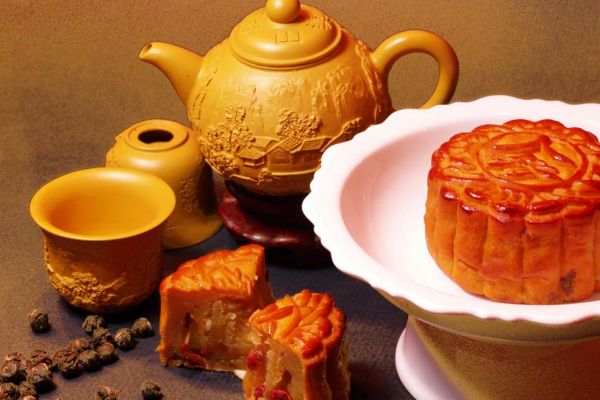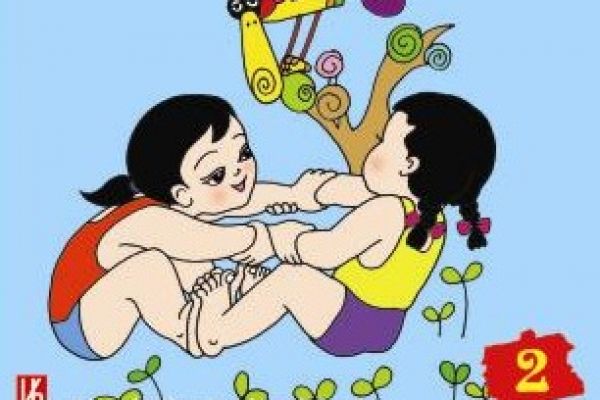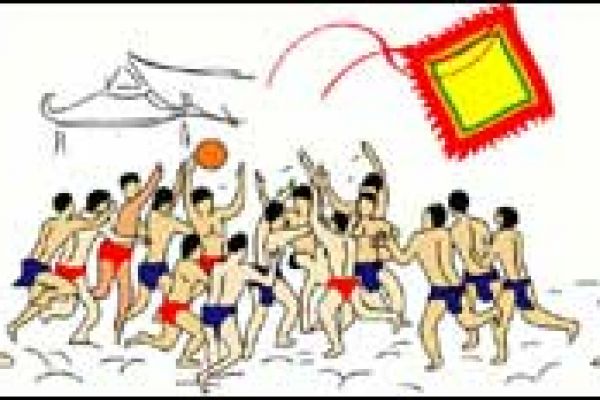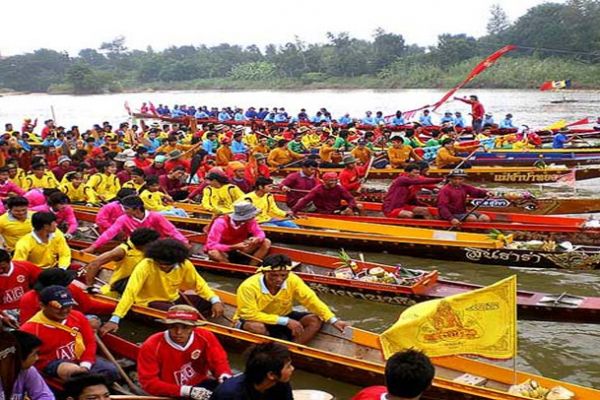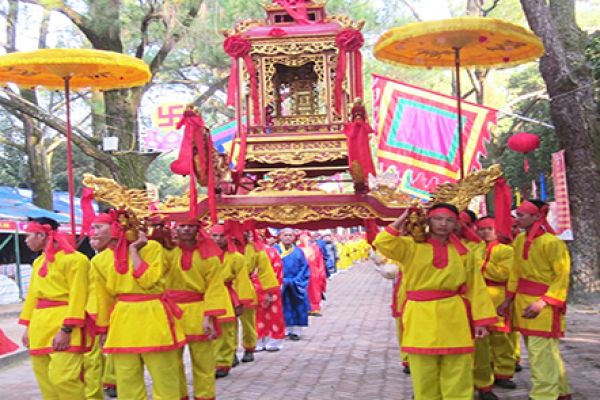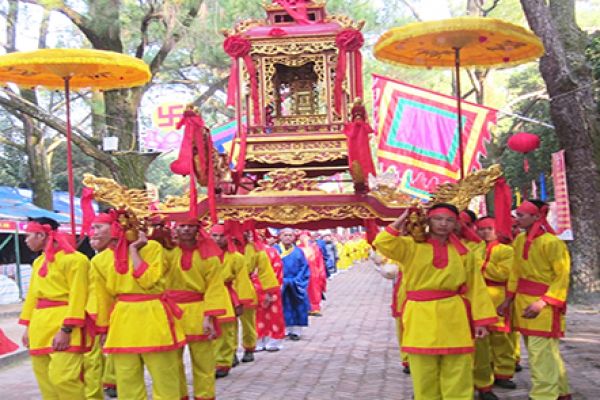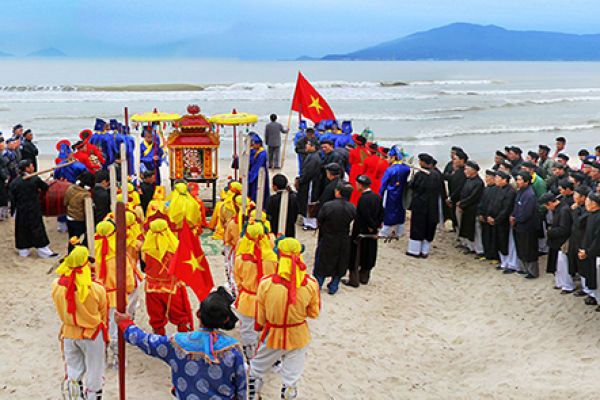Visitors come to this village all the year round for several reasons. The village and Sài Sơn Mountain provide well-known scenic sports involving a nice lake (Long Trì Lake) which has in the middle of it a big house fro viewing yearly water puppets shows and two wooden bridges with curved tiled roofs, and many beautiful mountain caves. The mountain also has, as its foot and on its slopes, a number of old pagodas the most well known of which is the Thầy Pagoda where is also worshiped Từ Đạo Hạnh, a monk of the Lý Dynasty who hailed from Láng Village (Hà Nội) and was endowed with supernatural powers.
Both the Thầy and Láng Pagodas Festivals are held in early March of each year, but differ from each other in terms of specific rites and ceremonies.
The Thầy Pagoda Festival is actually a joint festival of four villages (Thụy Khê, Đa Phúc, Khánh Tân and Sài Khê). While the whole area has many pagodas, the Festival is held mainly in Thiên Phúc Pagoda, alias Thầy Pagoda, which comprises three buildings: ante-chamber, Buddha’s Building, and the Building of the Genius. It is said that Từ Đạo Hạnh led a religious life and died in this very pagoda. At the end of his life, he sat in meditation for several months without food and drink and died in the process. Thereafter, the people put his withered corpse in the Building of the Genius for the purpose of worship. The Ming invaders who ruled over Việt Nam from 1407 to 1427, took Từ Đạo Hạnh’s corpse to a mount and burned it. Thereafter, the local population collected his ashes and mingled them with earth in order to make a statue for worship. From then on, the mount was called the Burning Mount.

Thầy Pagoda, Quốc Oai District, Hà Nội
Two most noteworthy events and distinctive features of the festival are the procession of the tablets and the water show.
The procession of the tablets takes place on March 7, in which all the four villages take part. The local population believes that Từ Đạo Hạnh first learned supernatural powers and became a genius, and at later time, embraced Buddhism. Therefore at the start of the procession, his tablets must be wrapped in a piece of yellow cloth (the color of the robes worn by priest endowed with supernatural powers) and on the return trip the same tablets should be wrapped in the brown frock of a Buddhist monk. In the core of the procession, Buddhist nuns walk while recounting the feats of Từ Đạo Hạnh, first in learning supernatural magic and then in leading a religious as it is the time when night takes over from day, when darkness and night come into contact with each other. The order of the procession also has variations with specific significance. At the start of the procession, the tablet of the Spirit Protector and the Red Horse of Thụy Khê Village must come first, then follows the tablet of the Spirit Protector and the White Horse of Đa Phúc Village, then the tablet of the respective Spirit Protectors of Sài Khê and Khánh Tân Villages, and at the end comes the tablet of Từ Đạo Hạnh. The tablet of the Spirit Protector of each village is carried by people of the village concerned, while that of Từ Đạo Hạnh is carried by four persons appointed by the four villages. During the return trip, the tablet of the Spirit Protector and White Horse of Đa Phúc Village must come first, to be followed by the tablet of the Spirit Protector and the Red Horse of Thụy Khê Village, while the order with respect to the remaining components of the procession remains unchanged. The above change in the precedence of the Red and White horses is connected with a specific legend: When Từ Đạo Hạnh promised to reincarnate himself as the offspring of Marquis Sùng Hiền Hầu (younger brother of King Lý Nhân Tông) he told the Marquis: “When your wife is giving birth, you must notify me immediately so that I can perform the due rites.” As agreed, on that day, Sùng Hiền Hầu ordered some horsemen to rush to the Pagoda for this purpose. The Red Horse reached the pagoda first and brought in the news, while on the return trip to the White Horse outstripped the former and came home first.

Some Vajrayāna statues at the Thầy Pagoda
The second noteworthy item is the water puppet show, a traditional cultural activity related to wet paddy cultivation in the Red River Delta. This item comprises two basic components: puppets and water. The puppets are products of traditional popular wood sculptures and lacquer painting. The place for the puppet performance is lake or a part of the river. With its fluid nature and reflections, water can mirror efficiently the numerous changes in the color of the sky, the mountains, trees and leaves and give a mythical air to the performance. The artists must usually stay inside the water and direct the movement of the puppet through sticks and strings connected. Several festivals in various places do have water puppet shows but they are performed by professional groups coming from other localities and in improvised stages. But the Thầy Pagoda has a fixed and specialized stage – the big house in the middle of the Long Trì lake, also called the Dragon lake and the whole expanse of water – 15m long – from the house upto the bank of the lake which is much larger than the stage provided in other places, usually having a maximum length of 4 meters. The water puppet shows reflect either productive activities – paddy cultivation, duck breeding, fishing, cloth weaving, etc. - or games such as wrestling, unicorn dance or historical tales. The shows also draw from folk or classical theatrical plays.
The skits performed by the water puppets are usually shown, and silent (except for some occasional introductory remarks, and accompanying music, either folk or classical), but they reflect distinctly the life of population and their struggle against natural calamities and foreign invasions, for national development and defense. They fill the spectators with surprise and pleasure, and also pride in the rich imagination and dexterity of performers who created in this art. Indeed, the founder and teacher of the water puppet show is none other than Monk Từ Đạo Hạnh.
The Thầy Pagoda Festival is attractive to many because of the myth surrounding Monk Từ Đạo Hạnh and his feats, the beautiful scenery and the water puppet shows. Also, a romantic dimension must be added, as the labyrinth of caves and paths in the mountain are ideal for hide-and-seek games.
This is reflected in an old saying:
“The Thầy Pagoda area has the Cắc Cớ cave
“Young bachelors often remember it with nostalgia.”

